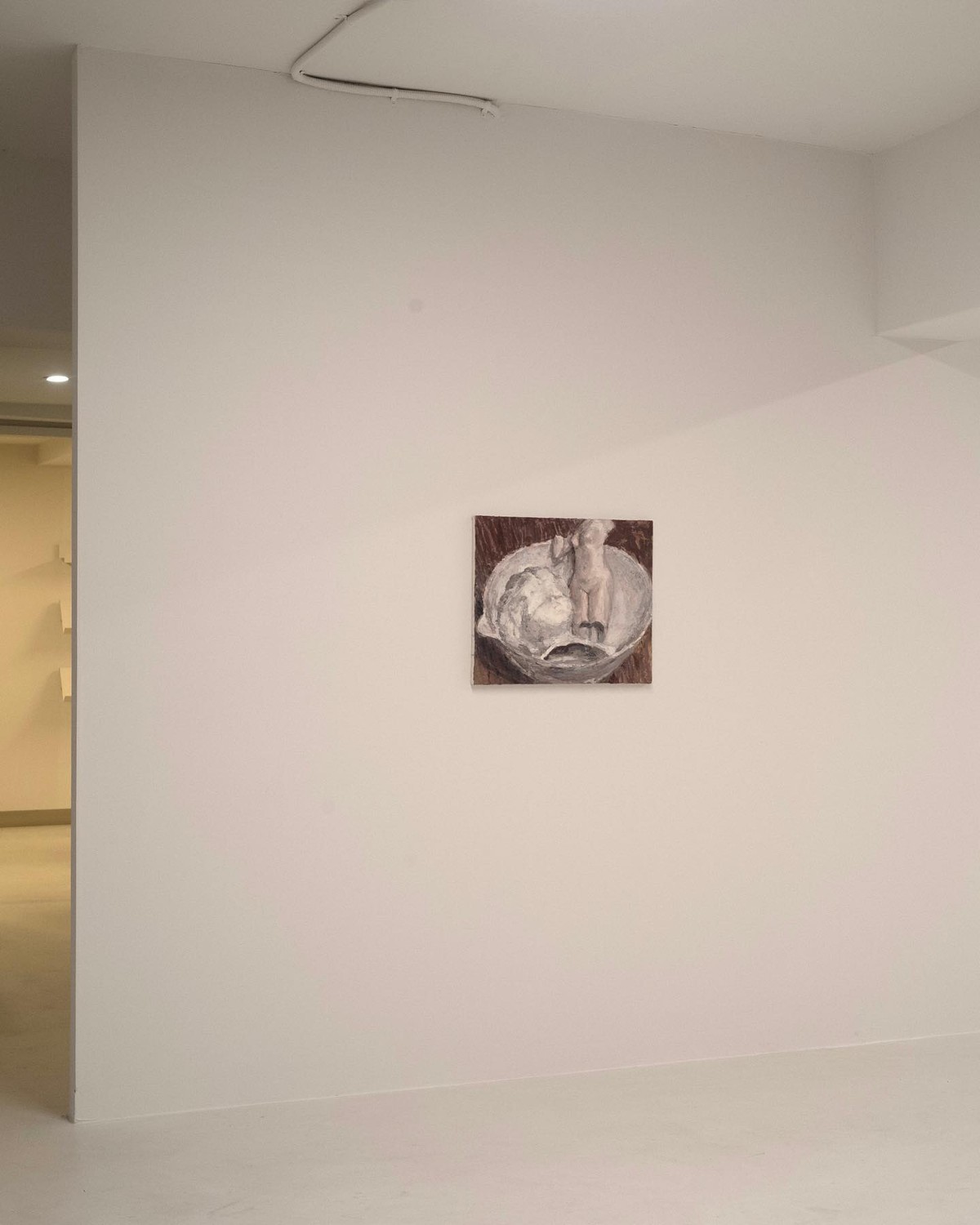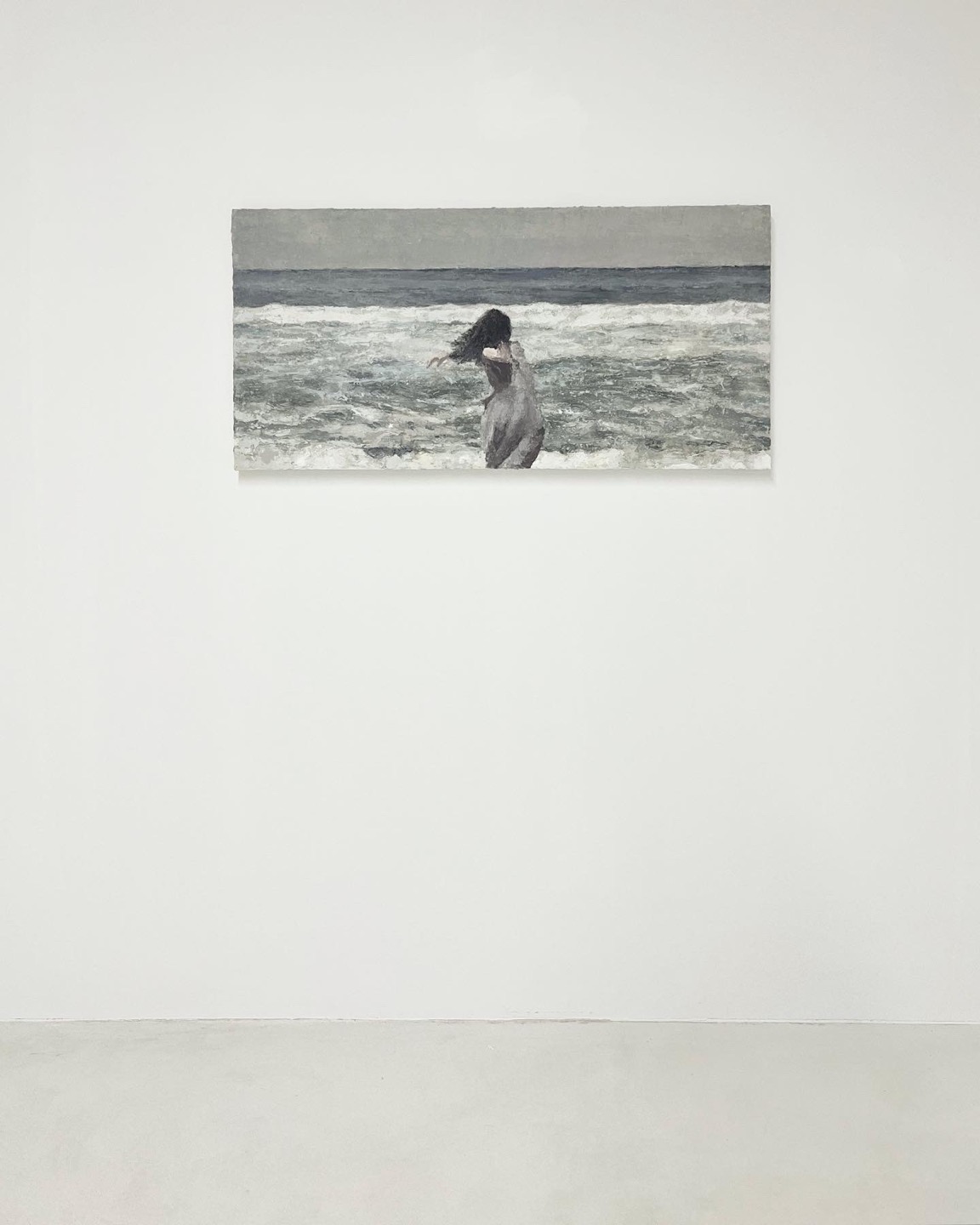
installation view

installation view

밤의 무늬 Tint of night, acrylic on canvas, 202245.5x 53cm, acrylic on canvas, 2022

불꽃놀이 Fireworks, oil on canvas, 116x91cm, 2021

목욕 Bath, oil on canvas, 78x94cm, 2021

내일 Tomorrow, acrylic on canvas, 98x49cm, 2022
어떤 인상들
지효섭 작가의 그림들은 빛과 어둠, 색채로 이루어진 기묘한 노래와 같다. 한 데 모여 온전한 맥락을 이루지 못할지언정 조각조각 빛나면서 매혹적이고 이상한 불협화음을 만들어 낸다. 기괴한 형태와 거친 붓질, 혼란스럽고 불안한 어두운 색채조차도 놀랍도록 천진난만하고 순수한 뉘앙스를 풍긴다는 점이 내겐 이상하고, 또 그만큼 흥미롭다. 그가 학생 시절 교과서의 귀퉁이에 반복해서 그려넣곤 했다는 괴물 같은 형상은 여전히 작가의 손을 떠나지 않았다. 당시 그 존재의 의미가 무엇이었을지 궁금해 하기보다는, 그저 오늘날 작가의 그림 속에서 그것이 어떤 모습으로 살아 있는 지를 생각해 보는 것 정도면 충분하다. 설명할 수 없는 매혹과 두려움, 그리고 신비는 세월에 따라 그 모습은 변할지라도 여전히그의 작품 세계 중심에서 한결같은 중력을 유지하고 있다. 대체로 감상자의 입장에서는 작품 속에서 특정 소재가 계속해서 등장하거나 더욱 공들여 묘사되어 있을 때면 그 소재의 일반적이고 관념적인 의미에 대해 생각을 하게 된다. 그러나 지효섭 작가의 그림을 그런 상투적인 시선으로 감상하는 일이 얼마나 소모적이고 의미 없는 일인지 깨달은 뒤로는 완전히 다른 방향에서 접근해야 한다는 결론에 이르렀다. 그의 소재들은 정물, 인물, 풍경, 동물 모두 하나같이 개인적이고 내밀한 이야기만을 담고 있기 때문이다. 이를테면, 여자의 나신이 그려져 있다고 하더라도 그건 틀에 박힌 섹시함이나 애틋한 모정 따위
를 보여주고자 하지 않는다. 그가 그린 ‘몸’은 캔버스 위에 물감으로 그려진 사물로서의 회화적 아름다움만을 가지고 있다는 느낌이 든다. 당신은 이에 대해 분석적으로 깊이 생각할수록 더욱더 함정에 빠지는 기분만 들 것이다. 모차르트의 음악이 어린이들에겐 쉬운 반면 전문 연주자들에겐 아주 어렵다는 말도 결국 무언가를 진정으로 이해하고 즐기는 일에 어떤 자세가 필요한 지에 대한 이야기다. 미련 없이 쓸데없는 고민을 멈추자. 그러나 공공연한 몰이해가 안타까울 이유는 전혀 없다. 우선 작가 본인에게 그것이 전혀 아쉬운 부분이 아니기 때문이고, 다음으로는 그것이 오히려 일반적이고 자연스러운 일이기 때문이다. 어떤 복잡하고도 미묘한 표현의 매커니즘에 의해 화가들은 종종 가장 드러내고 싶은 것 일수록 감추고, 지우고, 빙 돌아가길 자처하는 경우도 많다. 그러나 여기 우리의 화가는 여전히 ‘자신이 보고 싶은 풍경’을 그려내는 중이고, 당연하겠지만 보고 싶어 그리는데 감출 필요는 없는 것 아니겠는가. 그럼 그가 어떤 대상을 그리느냐 하는 문제 말고는 무엇에 대해 생각해 보는 게 재미있을까. 끌로드 드뷔시(Claude A. Debussy 1862~1918)가 「라 르뷔 블랑슈 La revue blanche」 에 음악 평론을 게재 하면서 속 시원히 속엣 말을 내뱉기 위해 만들어낸 냉소적인 alter ego인 크로슈 씨는 베토벤과 바그너의 음악에 대해 이렇게 표현했다. 베토벤의 관현악이 아주 연한 회색에서 짙은 회색까지의 명도표 같은 반면, 바그너는 다채로운 색상을 가졌지만 거의 균일하게 펼쳐져 있는 색채 안료들의 조합 같다는 것이다. 비록 음악의 이론이나 객관적 분석과는 거리가 멀지만 무슈 크로슈의 언어는 직관적이고 감각적으로 누구나 쉽게 납득할 수 있다. 지효섭 작가의 작품을 이해하기 위한 중요한 요소 중 하나인 빛과 어두움에 대해 생각하다가, 나는 문득 무슈 크로슈의 ‘명도표’를 떠올렸다. 가까이에서 들여다보았을 때 지효섭 작가
의 색채는 분방한 필치와 더불어 분명 개성적이고 매력적이지만, 화면 전체적으로 보았을 때는 늘 의식적으로 절제하고 있는 느낌이다. 그에 비해 작가의 ‘명도표’는 그 대비가 미친 듯이 과감한 단계부터 안개에 잠긴 듯 부드럽게 섞이는 미묘한 단계 까지 그 폭이 넓다. 그리고 이것은 그의 작품 세계에서 중요한 표현 도구의 하나로 훌륭하게 기능하고 있다. 작가의 의도는 별로 생각하고 싶지 않다. 그저 그림 속의 칠흑 같은 어두움은 내게 어떤 종류의 무한함, 영원함, 거의 종교적이라고 할 수 있을 숭고함을 떠올리게 하고, 또 그런 어둠 가운데 희미하게 반짝이는 빛은 고독감과 안온한 슬픔을 불러온다는 사실이 더 소중하다. 지금 이곳에 서있는 당신의 감상은 전혀 다르기를. 당신만의 신비롭고 이상한 이야기가 생겨난다면 참 멋질 것이다. 이 작가의 그림을 무척 좋아하는 나로서는 이번 전시가 무척 감사한 기회이다. 그의 최고의 그림을 찾고 싶다기보다는 그저 가능한 한 오랫동안, 뭐가 되었든 더 많은 그림을 보고 싶다. 이곳에 걸려있는 그의 그림을 본다. 이 그림들은 어디에서 시작되는 것일까? 화가의 어둠 속, 그러나 신비한 빛이 섞여드는 그 어디쯤에서, 사각사각 흔들리고, 숨 쉬고, 밀려오고, 날아가는 그 모든 것들은 그에게 생생한 흔적을 남긴다. 아마도 그곳에서부터 이 모든 이야기는 시작되는 것이 아닐까.
먹구름
(ENG)
Some Impression
Ji Hyo Sub's paintings are like strange songs composed of light, darkness, and colors. Even if they do not come together to form a complete context, they shine piece by piece, creating a fascinating and strange dissonance. It's strange to me, and just as interesting, that even the bizarre forms, rough brush strokes, and the chaotic and disturbing dark colors give me a surprisingly innocent and pure nuance.
The monstrous figure that he used to draw repeatedly in a corner of his textbook during his school days still has not left the artist's hand. In my opinion, rather than wondering what the meaning of that existence was at the time, it is just enough to think about what it looks like in the artist's paintings today. The inexplicable fascination, fear, and mystery still maintain a consistent gravity at the core of the world of his art, although its appearance may change over time.
In general, from the perspective of the viewer, the general and ideological meaning of the object is considered important when a specific object continues to appear or is more elaborately depicted in the painting. However, after realizing how exhausting and meaningless it was to appreciate Ji Hyo Sub's paintings from such a conventional perspective, I came to the conclusion that I should approach them from a completely different direction. This is because his themes such as still life, figure, landscape, and animal contain only personal and innermost meanings. For example, even if a woman's body is depicted, it does not intend to show stereotypical sexiness or affectionate motherhood. I think that the “female body” he painted has only pictorial beauty as an object drawn with paint on canvas. The deeper you think about it analytically, the more you will feel trapped.
The saying that Mozart's music is easy for children but very difficult for professional musicians is ultimately about what kind of attitude is needed to truly understand and enjoy something. Let's stop useless thinking without regret. However, there is no reason to feel sorry for the public's lack of understanding. First of all, it is because the artist himself is not uncomfortable at all with that, and secondly, It is rather normal and natural that people do not understand the artist. By some complex and subtle mechanism of expression, painters often hide, erase, and indirectly reveal what they want to reveal most. However, our painter here is still painting the scenery that he wants to see himself, and of course, there is no need to hide because he is the one who wants to see the most than anyone else.
Then what else would be fun to think about besides the question of what kind of object he draws? Monsieur Croche, a cynical alter ego created by Claude A. Debussy (1862-1918) in order to spit out his innermost words to his article in 「La revue blanche」, said the following about Beethoven and Wagner's music. Whereas Beethoven's orchestral music is like a gray scale chart from very light gray to dark gray, Wagner's is like a combination of colorful but almost evenly spread color pigments. Although far from the theory or objective analysis of music, Monsieur Croche's language can be easily understood by anyone intuitively and sensibly. While thinking about light and darkness, one of the important parts to understand Ji Hyo Sub's work, I suddenly thought of Monsieur Croche's "gray scale chart". When you look closely, Ji Hyo Sub's color is clearly unique and attractive along with his freewheeling brush strokes, but overall, he always seems to be consciously restrained. In comparison, the artist's "gray scale chart" has a wide range of contrast from the crazy bold stage to the subtle stage where the contrast is gently blended as if submerged in fog. And it's functioning wonderfully as one of the important expression tools.
I don't want to think much about the artist's intentions. It is more precious the fact that the pitch-black darkness in the painting reminds me of some kind of infinity, eternity, and sublimity which can be said to be almost religious, and that the faint light in the darkness brings loneliness and sweet sadness. Now you're standing here looking at his painting. And I hope your impression is completely different from mine. It would be great to have your own mysterious and strange story. As a big fan of him, this exhibition is a very grateful opportunity for me. Rather than looking for his greatest masterpiece, I just want to see more of his paintings no matter what they are for as long as possible.
I look at his paintings hanging here. Where did these paintings start? In the darkness of his heart, but somewhere dimly lit by mysterious light, everything that shakes, breathes, rushes, and flies leaves a vivid mark on him. Maybe that's where the whole story begins.
Muggurum